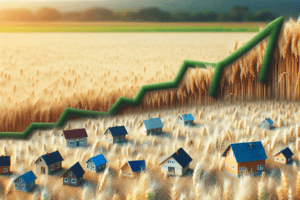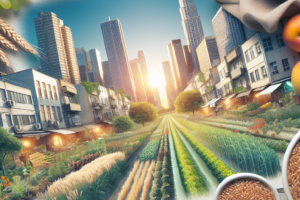Urbanization has a profound impact on various aspects of society, including dietary patterns and food consumption. One of the most significant changes observed in urban areas is the shift in grain consumption. As cities grow and populations become more concentrated, the demand for grains evolves, influenced by factors such as lifestyle changes, economic development, and cultural shifts. This article explores the relationship between urbanization and grain consumption, examining the underlying factors that drive these changes and their implications for food security and agricultural practices.
The Shift in Dietary Patterns
Urbanization leads to significant changes in dietary patterns, primarily due to the increased availability of diverse food options and the influence of modern lifestyles. In urban settings, people often have access to a wider variety of foods, including processed and convenience items, which can alter traditional grain consumption habits.
Increased Demand for Processed Foods
As urban populations grow, there is a marked increase in the demand for processed foods. These foods often contain refined grains, which are more palatable and convenient than whole grains. The fast-paced lifestyle of urban dwellers, characterized by long working hours and limited time for meal preparation, drives the consumption of ready-to-eat meals and snacks. This shift can lead to a decline in the consumption of whole grains, which are essential for a balanced diet.
Changing Cultural Influences
Urbanization also brings about cultural changes that influence food preferences. As people migrate to cities, they are exposed to new culinary traditions and eating habits. This exposure can lead to a preference for grains that are staples in urban diets, such as rice and wheat, while traditional grains may be overlooked. Additionally, the globalization of food markets introduces a variety of grains from different cultures, further diversifying urban diets.
Economic Factors and Grain Consumption
The economic landscape of urban areas plays a crucial role in shaping grain consumption patterns. As cities develop, income levels typically rise, leading to changes in purchasing power and food choices.
Income and Food Choices
Higher income levels in urban areas often correlate with increased spending on food. Urban consumers may prioritize quality and convenience, opting for premium grain products or specialty items that cater to health-conscious trends. This shift can result in a decline in the consumption of staple grains, as consumers gravitate towards more expensive, processed alternatives.
Food Security and Accessibility
Urbanization can also impact food security and accessibility. While cities may offer a wide variety of food options, not all urban residents have equal access to these resources. Low-income populations may rely on cheaper, less nutritious grain products, which can exacerbate health disparities. Furthermore, the concentration of food deserts in urban areas can limit access to whole grains and fresh produce, leading to a reliance on processed foods that are often high in refined grains.
Environmental Implications of Urban Grain Consumption
The shift in grain consumption patterns due to urbanization has significant environmental implications. As demand for certain grains increases, agricultural practices must adapt to meet these needs, often leading to unsustainable farming methods.
Intensive Farming Practices
To keep up with the rising demand for grains in urban areas, farmers may resort to intensive farming practices that prioritize yield over sustainability. This can result in soil degradation, loss of biodiversity, and increased use of chemical fertilizers and pesticides. The environmental impact of these practices can have long-term consequences for food production and ecosystem health.
Transportation and Carbon Footprint
Urbanization also affects the transportation of grains, contributing to a larger carbon footprint. As cities grow, the distance between agricultural production areas and urban centers increases, leading to higher transportation emissions. This reliance on long-distance food transport not only impacts the environment but also raises concerns about the freshness and quality of grain products available in urban markets.
Future Trends in Grain Consumption
As urbanization continues to shape food consumption patterns, several trends are emerging that may influence the future of grain consumption in cities.
Health and Wellness Trends
With a growing awareness of health and wellness, urban consumers are increasingly seeking out whole grains and healthier alternatives. This trend is reflected in the rise of health-focused brands and products that emphasize the nutritional benefits of whole grains. As more people prioritize their health, the demand for whole grains may increase, potentially reversing some of the declines seen in traditional grain consumption.
Sustainable Practices and Local Sourcing
There is also a growing movement towards sustainable agricultural practices and local sourcing of food. Urban consumers are becoming more conscious of the environmental impact of their food choices, leading to a preference for locally grown grains and organic products. This shift could encourage more sustainable farming practices and support local economies, ultimately benefiting both consumers and producers.
Conclusion
The relationship between urbanization and grain consumption is complex and multifaceted. As cities continue to grow, the demand for grains will evolve, influenced by dietary changes, economic factors, and environmental considerations. Understanding these dynamics is crucial for addressing food security challenges and promoting sustainable agricultural practices. By recognizing the impact of urbanization on grain consumption, stakeholders can work towards creating a more resilient and equitable food system that meets the needs of urban populations while safeguarding the environment.













